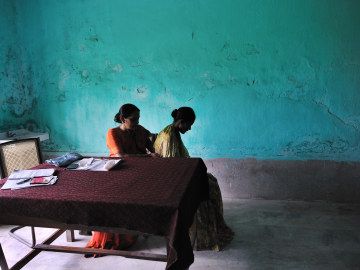An Obscure Disease Hits WHO Where It Counts
GENEVA —This week at the World Health Assembly, delegates have been forced to consider an obscure flesh-eating infection called mycetoma because it may change the way the WHO does business.
In January, Sudan, Egypt, Jordan, Canada and several other countries asked the WHO to add mycetoma to their list of diseases that afflict the poor—a key step toward securing research funding. It seemed that the WHO Executive Board would oblige, until U.S. representatives complained about the addition on principle. “The problem,” explains Jimmy Kolker, assistant secretary for Global Affairs at the US Department of Health and Human Services, “is that the WHO has no mechanism for deciding what deserves to be on their list.”
In response to the US, the WHO’s neglected disease department recently proposed an entirely new process for adding diseases to the list—one that the head of the department, Dirk Engels, hopes will decrease political jostling. Rather than rely on pressure from countries for or against additions, such as mycetoma, delegates would submit their disease of choice to a WHO technical committee that evaluates the candidate based on evidence. Today, when the suggestion of adding mycetoma to the list comes up at the Assembly, delegates will simultaneously consider the new process.
The Department posted their criteria recently as well: The condition must be relatively ignored by researchers and cause important morbidity, mortality, stigma and discrimination to people living in tropical areas and in poverty. I’ve italicized the words relatively and important to highlight the more malleable elements of the criteria.
“Prioritization is not an established science,” says Seurie Moon, a global health expert at the Harvard School of Public Health. “Some facts matter, like morbidity and mortality rates, and then there are the less objective variables—who is a good advocate, what are the interests of funders.” In a perfect world, people calculate decisions based on quantifiable parameters. But in real life, people possess limited facts, limited experience, and implicit bias. These variables compound when it comes to neglected diseases precisely because the territory is uncharted. Scientists don’t even know how many people have mycetoma. They don’t know if it’s a single condition, or multiple.
What diplomats understand about mycetoma is that it is probably super bad. Kolker tells me his colleagues at the US embassy in Sudan feel awful about people they’ve met with limbs overwhelmed by fungi. And a former WHO representative in Sudan, Anshu Banerjee, recalls his response to mycetoma patients: “I was taken aback because the disease is so gross.” But these are anecdotes. And the US has requested that decisions be technical.
But no decision on the prioritization of complex problems can ever be completely technical. Everyone, including the US government, has a secret sauce. According to an analysis led by economist Roderik Viergever, at the Radboud Institute for Health Sciences in the Netherlands, the world’s biggest health research funders distribute their money in inexplicably diverse ways. More than half of the U.S. federal infectious disease budget goes to HIV/AIDS, for example, whereas Australia allocates just 10% of the analogous budget to HIV/AIDS. “Health research funding decisions are not only made on the basis of what research is needed, but are regularly influenced by other factors, such as political interests, advocacy, and lobbying,” the authors conclude. Indeed, AIDS activists in the US have clout.
This past Monday—opening day for the 69th World Health Assembly—delegates from developing nations filled every chair at a session to announce “ESPEN,” a 10-year WHO initiative to eliminate five neglected tropical diseases for which treatments exist: onchocerciasis, lymphatic filariasis, schistosomiasis, soil helminthes, and trachoma. Toward the close of the session, a delegate from South Sudan asked why there were just five. “What about other neglected tropical diseases? Do we drop them?”
When the meeting let out, the delegates exchanged thoughts in the hallway. I sat on an auburn bench beside Cherif Baharadine, the director for communicable and non-communicable diseases in Chad. He felt pleased with the initiative but let down by the arbitrary number five. “Some diseases will be left by the wayside,” Baharadine said, “It is perpetually like this.”
As for mycetoma, today the delegates will decide whether it sits in the the sun or the thicket.
Editor’s Note: Amy Maxmen reported on mycetoma in Sudan for the Global Health NOW series, “The Most Neglected Disease.” Mycetoma was the selected as the Untold Global Health Story of 2015 by GHN and the Consortium of Universities for Global Health.
Join the thousands of subscribers who rely on Global Health NOW summaries and exclusive articles for the latest public health news. Sign up for our free weekday enewsletter, and please share the link with friends and colleagues: Subscribe to GHN





